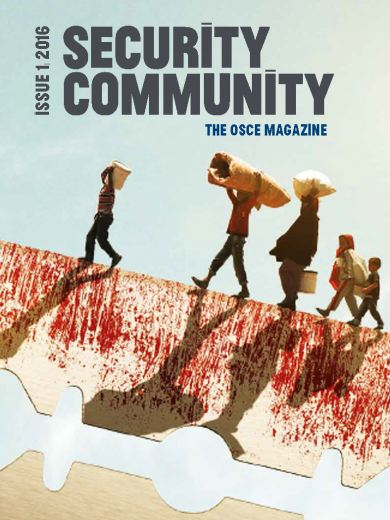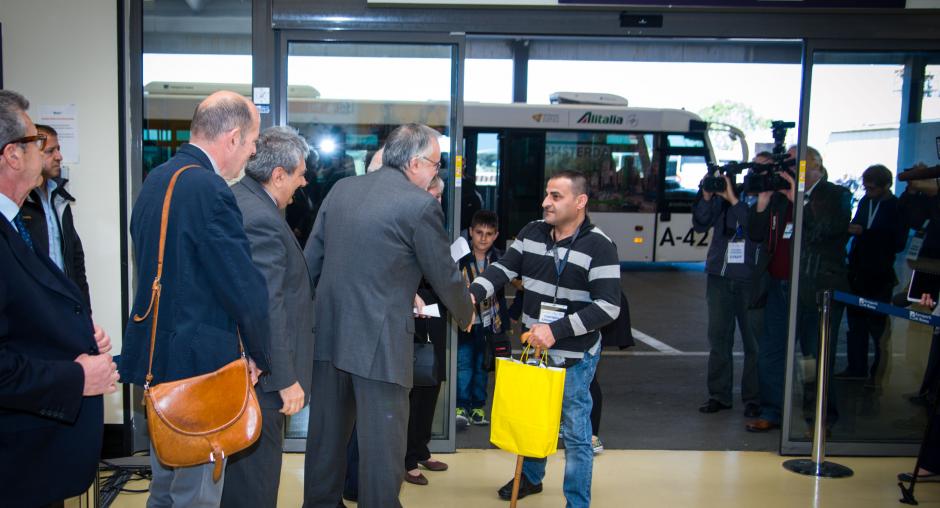Beyond Good Intentions: Creating Safe Passage to Italy
Creative thinking by three faith communities and the Italian Government has led to a procedure for issuing special humanitarian visas for Italy to potential asylum-seekers in transit in Lebanon, Morocco and Ethiopia. They are fully screened before entering the country and immediately integrated into a community network, all without cost to the government budget. The project is awakening interest in other European countries and deserves to be replicated. Cesare Zucconi, Secretary-General of the Community of Sant’Egidio, explains.
How did you come upon the idea of creating humanitarian corridors?
It was not possible for us in the Community of Sant’Egidio to look on any longer at so many people dying at sea while trying to reach the shores of Europe. After the tragic shipwreck off the coast of Sicily in October 2013, in which hundreds of migrants drowned, and the visit of Pope Francis to Lampedusa, we began to study European law, looking for safe ways for refugees to reach the European Union. We discovered that Article 25 of the European Union’s Visa Code gives member states the possibility of issuing at their discretion visas with limited territorial validity, for humanitarian reasons or national interest or because of international obligations. So there was a legal provision for bringing refugees to Europe safely, but apart from a few isolated cases, it was not being implemented.
Together with the Waldensian Church and the Federation of Evangelical Churches in Italy, we proposed to the Italian Government to issue a certain number of these humanitarian visas. After negotiations with both the Ministry of Foreign Affairs and the Ministry of the Interior, we – the three faith communities and the two ministries – were able to sign a memorandum of understanding in December of last year. According to the agreement, we are allowed to open two and next year a third humanitarian corridor for refugees currently residing in transit countries – first Lebanon and Morocco and then Ethiopia. The Government has committed to issuing 1,000 entry visas to particularly vulnerable persons identified by the Sant’Egidio Community and its partners, who will provide them with safe transportation to Italy and host them until their applications for asylum have been approved. The visas are of limited territorial validity, for Italy only.
When did the first refugees come through the corridor?
The first family arrived in Rome from Lebanon on 4 February: seven-year-old Falak al-Hourani, suffering from a rare form of eye cancer, together with her parents and six year-old brother. Falak had already lost one eye and there was a high risk of the cancer spreading also to the other. She had no chance of being treated in Lebanon. When the family arrived, she was immediately admitted to the children’s hospital in Rome. Now, four months later, her health is improving. The family is living in a house run by Sant’Egidio, together with other refugee families. The two children are going to school and already speak some Italian. The parents are also learning Italian at our school for language and culture.
Falak and her family were followed on 29 February by 93 Syrian refugees from Lebanon, among them 41 children. On 3 May another group of 101 refugees came through the corridor the same way. They had fled from Syria and Iraq– from Homs, Aleppo, Hama and Hassaka, near the Iraqi border not far from Mossul.
Why did you begin with Lebanon as country of origin?
Lebanon was an obvious choice because of the many Syrian refugees. In Lebanon, which has a population of around 4 million, there are 1.2 million refugees – that’s one out of five residents. There are the Syrian refugees and – this is sometimes forgotten – there are still half a million Palestinians living in camps like Shatila. Lebanon deserves recognition for taking them, but the country is utterly overwhelmed. Refugees have almost no access to health care or schools. We are speaking of around 400,000 children, most of whom have not been attending school for five years. What does it mean when children grow up with no school and no prospects? They can become the future soldiers of rebellion against wealthy countries.
I have spoken with many Syrian refugees in Lebanon, and most of them told me they had no desire to go to Europe; they were in Lebanon because they wanted to go back home as soon as the war came to an end. But now they are facing the fact that there is no end in sight to this war. Their homes are totally destroyed – the pictures of Homs or Aleppo today remind one of Berlin or Dresden after World War II. After five years or so in Lebanon, they are drained of their resources and need of move on. They are trying to go, but it is difficult.
How do you find beneficiaries for the programme?
We look for people who are particularly vulnerable: sick children, women in difficulties, handicapped people. Our criteria are similar to those of the United Nations for determining people worthy of refugee status. But we also consider people who may not fall under this category but have a proven condition of vulnerability due to their personal situation, age or medical condition. We try to help families stay together, not divide them.
The Sant’Egidio Community has many contacts in Lebanon; we know all the churches and the government and Muslim leaders. We also have links with Syrians outside of Lebanon, including in the European Union, who tell us when they know of a particularly difficult case. We meet the people, speak with them and try to determine if coming to Italy is really a solution for them. If we find that it is, we add them to our list of potential beneficiaries, which we pass on to the Italian consular authorities. The list is then checked by the Italian Ministry of the Interior. This is one of the characteristic features of our programme: the beneficiaries have given their fingerprints and gone through security checks by the Lebanese and the Italian authorities before even leaving the country. Once their files are approved, the consular authorities issue
humanitarian entry visas and we put them on a plane to Rome.
What happens to the beneficiaries once they arrive in Italy?
Like every other asylum seeker entering our country, they have to go before a commission, which decides whether or not they can be recognized as refugees. If they are recognized, they get the right to stay. Until that decision is taken, they are entirely under our care. They are welcomed and hosted by us and our partner organizations. This is an important difference between our programme and, for instance, the United Nations resettlement programme: we take full care of the beneficiaries until they have been given refugee status. This means housing and feeding them and it also means letting them benefit from our network of solidarity. The Community of Sant’Egidio has been running schools of Italian language and culture for newcomers to Italy for more than thirty years. We have schools in a whole series of Italian cities today.
We find it very important to put the children in school immediately. After ten days, they already more or less speak Italian. Children are very quick, it’s not difficult for them to learn a language and adapt. But it is very important for them to be introduced into community life. Integration can only happen within a community– with both long-time Italians and other newcomers. This is very important. We help the families not only to learn Italian, but also to find a job, deal with legal issues in connection with being recognized as refugees and get help if they have health problems. We also do a lot to welcome their religious tradition. For instance, we provide space for the celebration of the Muslim feasts in our schools. We have nothing to gain from people losing their faith.
How are the humanitarian corridors financed?
All of the costs are borne by us – the three faith communities. We pay for the flight to Italy and we bear the full cost of hosting the families for the first period of their stay in Italy, until they are recognized as refugees, no matter how long it takes. The Waldensian Church and the Federation of Protestant Churches are contributing the church taxes which citizens pay; they are providing most of the funding. We are also receiving help from generous citizens. The humanitarian corridors don’t cost the Italian Government a cent. This, together with the fact that the refugees are fully screened before entering the country and immediately integrated into community life, is what sets our programme apart.
Obviously, we are aware that we are speaking of quite a small number of people – although, actually, one cannot say that 1,000 is a small number because every life which can be saved is important. But we are thinking of this as a pilot project, which may encourage other countries and institutions to do the same.
What is your message to others who might wish to follow your example?
I think others are watching our initiative and I hope they will be inspired by the results: the fact that people are entering in a safe way, are remaining in Italy and are being integrated. They are not just going through the official procedures and then left to fend for themselves, as unfortunately often happens with asylum seekers. I think also for the Italian Government, there is reason to be proud, because they did something very new, very creative, which other countries might follow.
I see a great willingness among citizens in the European Union, in Germany, for instance, and also in other countries, to do something for the refugees. We are receiving proposals of help from individuals and also from civil society groups, to host a family, for instance. This is the idea of private sponsorship, which in fact is also foreseen in the European laws but is hardly implemented. Maybe it can also be a solution for other European countries – together with organizations, civil society and churches.
In the end, if you are realistic, you cannot close the doors to Europe, they will not be strong enough. Also, it is against our own interests, starting with economic interests – even apart from the obvious ethical concerns. In a global world, you cannot live with closed doors.
For more information:
Welcome to Security Community
Security Community is the OSCE’s online space for expert analysis and personal perspectives on security issues.
The views expressed in the articles are those of the authors and do not necessarily reflect the official position of the OSCE and its participating States.


